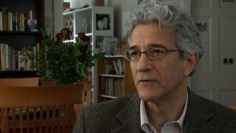LAURENCE REES: To what extent, when the Germans go into the Soviet Union with orders to target selected Jews, is this done with the knowledge that it is going to lead to ever greater killing of Jewish people?
OMER BARTOV: Well, you know, this is a huge debate and there is no consensus precisely on how these things happen, because we have all kinds of orders and all kinds of units and all kinds of documents and they can be interpreted in different ways. The first distinction you want to make is between the German military and these units, the Einsatzgruppen, the killing squads. They are commanded by different agencies - they are co-operating with each other - but the main difference is that the army’s main role is to fight with the enemies’ armed forces, and the main goal of the Einsatzgruppen is to destroy political and racial enemies of the regime. And primarily what they do is kill Jews. So this is one major goal that they have in mind. They’re not going to fight enemy units, they leave that to Wehrmacht.
Secondly, the transition from the killing of male Jews and the extermination of entire communities happens quite early, in August, so we are talking early July when they actually move into such communities. Late June, early July to August, it’s not a long time. And it happens at different times in different areas. It is possible that in part this has to do with local commanders. This is not a case, I would say, of brutalisation of the policemen who were doing that, though that does also exists, but it is changing orders both on the local level and on higher levels. There were commanders who were particularly keen on carrying out what they believed were their orders; that is to destroy entire communities, and they start doing that earlier than others. But in August Himmler goes on a visit to the Front and when he does that, in every place that he visits there seems to be a change in the policy.
We don’t have orders by him, but it is quite likely that he orally transmits the order that now it is time to destroy entire communities. Whether that is the beginning of the Final Solution or not is again another big debate, because what is happening there at that point in these communities is that people are being killed where they live. So a police unit marches into a town in Galicia, Lithuania or Belarus, rounds up the Jews, takes them aside and shoots them. They don’t transport them to any other place, they kill them on the spot. That could be seen as the beginning of genocide, of course, and it’s easily defined as genocide, but it is different from what happens later on when there are extermination camps and people are shipped there from all over Europe and killed in extermination facilities.
The killing of Eastern Jews
Professor Omer Bartov

- The German Military mentality in the Soviet Union
- Progression of the brutality in the East
- The killing of Eastern Jews
- Why were Jewish women and children killed
- The personal nature of the cruelty in the East
- Judaism and Communism
- Prejudice against Jews
- The difference between Soviet and Nazi evil
- Ukrainian reactions to the Soviets
- A potential Soviet genocide
- Most important WW2 turning point
- The leader with most enhanced reputation
- Biggest mistake of WW2
- Why study history and WW2 in particular
 Twitter
Twitter




